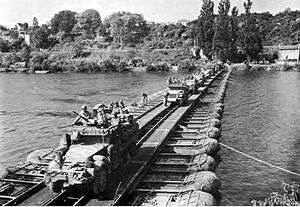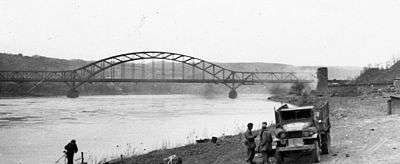291st Engineer Combat Battalion (United States)

The 291st Engineer Combat Battalion was one of the most decorated Engineer Combat Battalions of the United States Army during World War II,[1] playing notable roles both in the Battle of Bulge and the Rhine crossing at Remagen.
Commanded by Colonel David E. Pergrin, it earned a Presidential Citation for outstanding performance in action in the Ardennes, blowing up bridges and fighting as infantry in helping stunt the German advance towards Antwerp. It was also instrumental in building the first pontoon bridge across the Rhine at Remagen to take traffic pressure off the severely damaged Ludendorff Bridge before its tragic collapse. The span made a material contribution in facilitating the U.S. Army's drive into central Germany.[1]
Capabilities


As a combat engineer battalion the 291st was capable of providing a wide variety of combat support services essential to sustaining operating forces in the theater of war.[2] These spanned such diverse activities as construction, demolition, sanitation, map production, minefield clearing, and unit intelligence.
Combat engineer battalions also fielded defensive .30 cal. and .50 cal. machine gun squads, anti-tank rocket and grenade launchers, and were required to fight as infantry when needed.[3]
The range of services provided included but was not limited to:[4]
- Bridge (mobile, floating, fixed), rail, & road construction and maintenance
- Conducting river crossings by ponton/raft, motor-powered assault boats
- Demolition
- Placing/de-arming munitions, including mines
- Port & harbor maintenance and rehabilitation, including beachheads:
- Laying roads and unloading/loading supplies, vehicles & personnel from transport and cargo ships
- Camouflage
- Water supply and sanitation
- Map production
- Vehicle maintenance
- Establishing/maintaining supply and ammunition dumps
- Building barracks, depots, and similar structures
- Rescue & road patrols, bridge and road reconnaissance
- Clearing of debris and wreckage
- Serving as infantry when needed
These included the deployment and operation of assault boats and the construction of various pontoon bridges,[5] including M1 treadways, and modular steel truss Bailey bridges.
Presidential Citation
The 291st received a Presidential Citation for its "outstanding performance of duty in action" against the for holding a defensive position against a German offensive from 17 December to 26 December in the Ardennes during the Battle of the Bulge:
As authorized by Executive Order No. 9396 (sec. I, Bul. 22, WD, 1943), superseding Executive Order No. 9075 (sec. III, Bul. 11, WD, 1942), citation of the following unit in General Orders, No. 30. Headquarters First United States Army, 18 February 1945, as approved by the Commanding General, European Theater of Operations, is confirmed under the provisions of section IV, Circular No. 333, War Department, 1943, in the name of the President, of the United States as public evidence of deserved honor and distinction. The citation reads as follows:
The 291st Engineer Combat Battalion is cited for outstanding performance of duty in action against the enemy from 17 to 26 December 1944, in Belgium. On 17 December 1944, at the beginning of the German Ardennes break-through, the 291st Engineer Combat Battalion was assigned the mission of establishing and manning roadblocks south and east of Malmedy, and with the defense of the town itself. The battalion set up essential roadblocks and prepared hasty defenses. Shortly thereafter, numerically superior enemy infantry and armored columns moving in the direction of Malmedy were engaged. Though greatly outnumbered and constantly subjected to heavy enemy artillery, mortar, and small-arms fire, the officers and men of the 291st Engineer Combat Battalion stubbornly resisted all enemy attempts to drive through their positions. Repeated attacks were made by enemy armor and infantry on roadblocks and defensive positions and, in each instance, were thrown back with heavy losses by the resolute and determined resistance. The determination, devotion to duty, and unyielding fighting spirit displayed by the personnel of the 291st Engineer Combat Battalion, in delaying and containing a powerful enemy force along a route of vital importance to the Allied effort, are worthy of high praise.[6]
Images
- The 291st in Action
-

291st engineers disarm a booby-trapped Sturmgeschütz III during the Battle of the Bulge
-

The Ludendorff Bridge before its collapse into the Rhine
-

The Ludendorff Bridge after its collapse
-

Sign erected by 291st declaring their bridge the first over the Rhine at Remagen
See also
References
- 1 2 "First Across the Rhine". Retrieved 27 November 2014.
- ↑ Department of the Army Field Manual No. 4-0, Chapter 1 The Engineering element of providing the essential capabilities, functions, activities, and tasks necessary to sustain all elements of operating forces in theater at all levels of war.
- ↑ United States Government War Department Engineer Field Manual FM-5-5, Engineer Troops, 11 October 1943
- ↑ VI Corps History: What Did Combat Engineers Do?
- ↑ 549th Engineer Light Ponton Company History
- ↑ War Department Battle Honors–Citation of Units: GENERAL ORDERS WAR DEPARTMENT No. 24f, April 6, 1945
Additional reading
- The Battle of the Bulge
- Engineers in World War II
- Those Damned Engineers (video)
- Pegrin, David E., First Across the Rhine: The 291st Engineer Combat Battalion in France, Belgium, and Germany